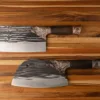Authentic Japanese Dashi Broth

Dashi is a fundamental broth in Japanese cuisine, serving as the base for many soups, sauces, and dishes. It’s an umami powerhouse, providing depth and flavor that elevates any meal. This simple recipe allows you to create a fragrant and flavorful dashi in no time, using just a few key ingredients.
Imagine a light, clear broth that bursts with the essence of the ocean and earth. This dashi is not just a recipe; it’s an invitation to experience authentic Japanese flavors right in your kitchen. With just dried kelp and bonito flakes, you can achieve a taste that transports you to a tranquil Japanese teahouse.
The Essence of Dashi
Dashi serves as a cornerstone in Japanese cuisine, offering a subtle yet profound flavor profile that enhances a variety of dishes.
Characterized by its light, clear appearance and aromatic qualities, this broth brings together the oceanic notes of kombu and the rich umami of bonito flakes.
Its delicate balance of ingredients creates a flavor base that seamlessly integrates into soups, sauces, and more, making it an essential component in many traditional meals.
Ingredient Highlights
The key ingredients in dashi include kombu and katsuobushi.
Kombu, a type of dried kelp, is rich in glutamic acid, which contributes to the umami flavor.
Katsuobushi, made from dried bonito fish, adds depth with its smoky, fishy notes.
Together, they form the backbone of this exquisite broth, showcasing the harmony of land and sea in every sip.
Preparation Techniques
Making dashi is a straightforward process that involves soaking and simmering.
The kombu is first wiped clean and soaked to extract its flavors.
Once the kombu is removed, the katsuobushi is added, creating a brew that is both nourishing and flavorful.
Straining the mixture ensures a clear broth that beautifully highlights its golden hue.
Serving Suggestions
Dashi can be enjoyed on its own or as a base for various dishes.
For a simple serving, a sprinkle of green onions can enhance its presentation and add freshness.
This broth pairs well with noodles, vegetables, or can be a delightful addition to miso soup.
The Cultural Significance of Dashi
In Japan, dashi is more than just a broth; it is a reflection of the culinary philosophy that values simplicity and purity of flavor.
It embodies the essence of Japanese cooking, emphasizing the natural tastes of ingredients without overwhelming them.
As a fundamental element, it connects various dishes and traditions, showcasing the importance of umami in Japanese cuisine.
Enjoying Dashi in Traditional Settings
Setting the stage for dashi can enhance the overall experience.
Consider serving it in traditional Japanese ceramics on a wooden table, creating a serene atmosphere that complements the broth’s delicate nature.
The visual appeal of the clear broth, garnished with green onions, paired with the elegance of the serving ware, makes for a truly authentic presentation.
Mastering the Art of Dashi
This dashi broth is light yet packed with umami, characterized by a delicate balance of flavors from kombu (dried kelp) and katsuobushi (dried bonito flakes). It’s a versatile foundation that enhances the taste of miso soup, noodle dishes, and more.
Ingredients
- 1 piece of kombu (about 10cm x 15cm)
- 4 cups of water
- 1 cup of katsuobushi (dried bonito flakes)
Instructions
- Prepare the Kombu: Wipe the kombu with a clean, damp cloth to remove any excess salt and impurities.
- Soak the Kombu: In a pot, combine the kombu and water. Let it soak for about 30 minutes to extract the flavors.
- Heat the Broth: Place the pot over medium heat and slowly bring to a simmer. Just before it starts boiling, remove the kombu. Boiling kombu can make the broth slimy.
- Add the Katsuobushi: Once the kombu is removed, add the katsuobushi to the pot. Allow it to simmer for about 5 minutes.
- Strain the Broth: After simmering, remove the pot from heat and strain the broth through a fine-mesh sieve or cheesecloth to separate the bonito flakes. Your dashi is now ready to use!
Cook and Prep Times
- Prep Time: 10 minutes
- Cook Time: 10 minutes
- Total Time: 20 minutes
- Servings: 4 cups
- Calories: 10kcal
- Fat: 0g
- Protein: 2g
- Carbohydrates: 1g












Add comment